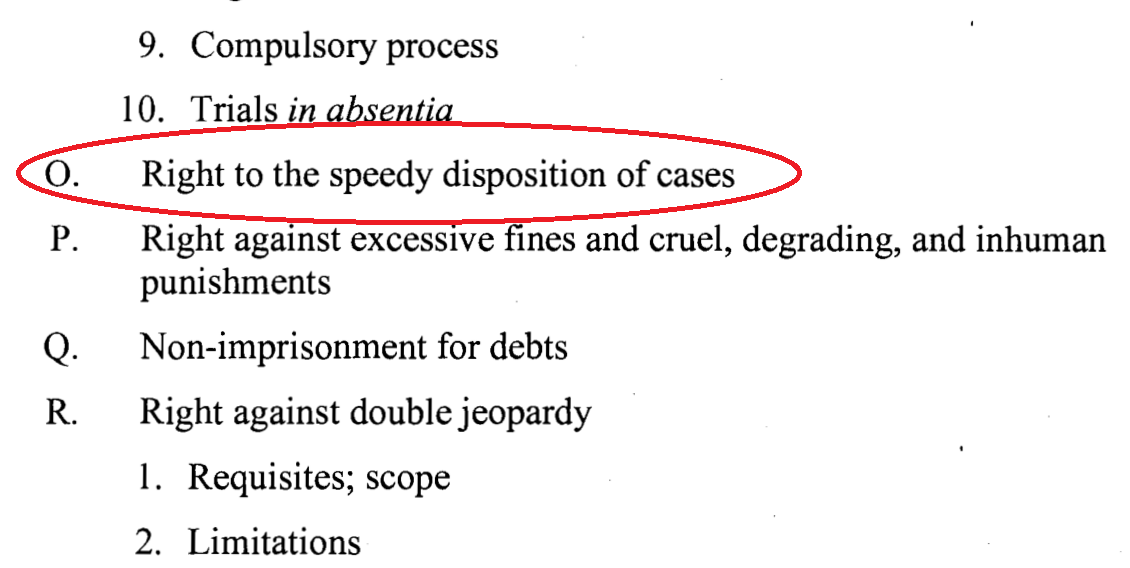We’ve discussed the principle behind this right when we talked about the right to speedy trial.
So what’s the difference between the right to speedy trial and the right to the speedy disposition of cases? It’s just the application:
“The right to a speedy trial is invoked against the courts in a criminal prosecution. The right to speedy disposition of cases, however, is invoked even against quasi-judicial or administrative bodies in civil, criminal, or administrative cases before them. As Abadia v. Court of Appeals noted:
‘The Bill of Rights provisions of the 1987 Constitution were precisely crafted to expand substantive fair trial rights and to protect citizens from procedural machinations which tend to nullify those rights. Moreover, Section 16, Article III of the Constitution extends the right to a speedy disposition of cases to cases “before all judicial, quasi-judicial and administrative bodies.” This protection extends to all citizens, including those in the military and covers the periods before, during and after the trial, affording broader protection than Section 14(2) which guarantees merely the right to a speedy trial.’“
–Cagang v. Sandiganbayan, 2018, penned by Justice Leonen
By the way, this Cagang case, aside from being a landmark case that abandoned a particular doctrine, is a gold mine for principles on the speedy disposition of cases.
Anyway, let’s get to Cagang. We already discussed what is considered as “delay” and the purposes of the time limits here. We also discussed the effects of the violation of the right which is dismissal of the case equivalent to an acquittal. We also discussed that the right to speedy trial can only be invoked after the complaint is filed. Before, in Ombudsman proceedings, this is not the case as there have been cases dismissed for the delay in fact-finding investigations prior to the filing of the case. Well, Cagang changed that.
What happened in Cagang is that, before, on Ombudsman proceedings, fact-finding investigations were considered to be covered by the right to the speedy disposition of cases. This is because the Ombudsman has a constitutional mandate to “act promptly”:
“While the right to speedy trial is invoked against courts of law, the right to speedy disposition of cases may be invoked before quasi-judicial or administrative tribunals in proceedings that are adversarial and may result in possible criminal liability. The right to speedy disposition of cases is most commonly invoked in fact-finding investigations and preliminary investigations by the Office of the Ombudsman since neither of these proceedings form part of the actual criminal prosecution. The Constitution itself mandates the Office of the Ombudsman to “act promptly” on complaints filed before it:
Section 12. The Ombudsman and his Deputies, as protectors of the people, shall act promptly on complaints filed in any form or manner against public officials or employees of the Government, or any subdivision, agency or instrumentality thereof, including government-owned or controlled corporations, and shall, in appropriate cases, notify the complainants of the action taken and the result thereof.“
–Cagang v. Sandiganbayan, 2018, penned by Justice Leonen
But such doctrine was revisited by Cagang:
“A dilemma arises as to whether the period includes proceedings in quasi-judicial agencies before a formal complaint is actually filed. The Office of the Ombudsman, for example, has no set periods within which to conduct its fact-finding investigations. They are only mandated to act promptly. Thus, in People v. Sandiganbayan, Fifth Division, this Court stated that a fact-finding investigation conducted by the Office of the Ombudsman should not be deemed separate from preliminary investigation for the purposes of determining whether there was a violation of the right to speedy disposition of cases.”
–Cagang v. Sandiganbayan, 2018, penned by Justice Leonen
After much deliberation, People v. Sandiganbayan was abandoned and it is undisputed now that fact-finding investigations are not covered by the right to the speedy disposition of cases:
“Considering that fact-finding investigations are not yet adversarial proceedings against the accused, the period of investigation will not be counted in the determination of whether the right to speedy disposition of cases was violated. Thus, this Court now holds that for the purpose of determining whether inordinate delay exists, a case is deemed to have commenced from the filing of the formal complaint and the subsequent conduct of the preliminary investigation. In People v. Sandiganbayan, Fifth Division, the ruling that fact-finding investigations are included in the period for determination of inordinate delay is abandoned.”
–Cagang v. Sandiganbayan, 2018, penned by Justice Leonen
Thus, the right to the speedy disposition of cases can only be invoked after the filing of the formal complaint and the subsequent conduct of the preliminary investigation. The same with the right to speedy trial. What they no differ is that the right to speedy trial does not apply on appeal.
Did we miss anything? Oh right waiver. The same with the right to speedy trial, there may be a waiver if the accused fails to invoke it. Delaying tactics and other reasons of the delay attributable to the accused also does not help:
“For the court to appreciate a violation of the right to speedy disposition of cases, delay must not be attributable to the defense. Certain unreasonable actions by the accused will be taken against them. This includes delaying tactics like failing to appear despite summons, filing needless motions against interlocutory actions, or requesting unnecessary postponements that will prevent courts or tribunals to properly adjudicate the case. When proven, this may constitute a waiver of the right to speedy trial or the right to speedy disposition of cases.”
–Cagang v. Sandiganbayan, 2018
I guess that’s about it. We’ll get to prohibited punishment next time.

